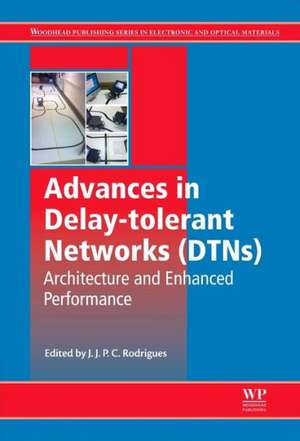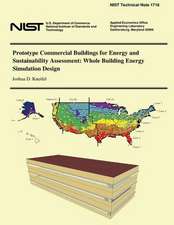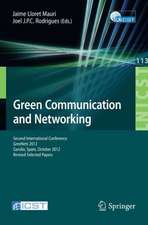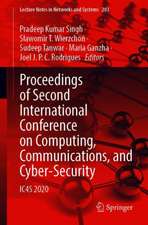Advances in Delay-tolerant Networks (DTNs): Architecture and Enhanced Performance: Woodhead Publishing Series in Electronic and Optical Materials
Editat de Joel J. P. C. Rodriguesen Limba Engleză Hardback – 10 noi 2014
- Reviews the different types of DTN and shows how they can be applied in satellite and deep-space communications, vehicular and underwater communications, and during large-scale disasters
- Considers the potential for rapid selection and dissemination of urgent messages is considered
- Reviews the breadth of areas in which DTN is already providing solutions and the prospects for its wider adoption
| Toate formatele și edițiile | Preț | Express |
|---|---|---|
| Paperback (1) | 1069.30 lei 36-50 zile | |
| ELSEVIER SCIENCE – 24 noi 2020 | 1069.30 lei 36-50 zile | |
| Hardback (1) | 1414.77 lei 36-50 zile | |
| ELSEVIER SCIENCE – 10 noi 2014 | 1414.77 lei 36-50 zile |
Din seria Woodhead Publishing Series in Electronic and Optical Materials
- 24%
 Preț: 1160.66 lei
Preț: 1160.66 lei - 18%
 Preț: 1299.95 lei
Preț: 1299.95 lei - 39%
 Preț: 1136.44 lei
Preț: 1136.44 lei - 9%
 Preț: 912.54 lei
Preț: 912.54 lei - 9%
 Preț: 956.68 lei
Preț: 956.68 lei - 24%
 Preț: 951.04 lei
Preț: 951.04 lei - 9%
 Preț: 1335.64 lei
Preț: 1335.64 lei - 29%
 Preț: 986.78 lei
Preț: 986.78 lei - 24%
 Preț: 874.56 lei
Preț: 874.56 lei - 29%
 Preț: 1075.95 lei
Preț: 1075.95 lei - 9%
 Preț: 1216.61 lei
Preț: 1216.61 lei - 39%
 Preț: 811.62 lei
Preț: 811.62 lei - 29%
 Preț: 1193.77 lei
Preț: 1193.77 lei - 9%
 Preț: 1444.32 lei
Preț: 1444.32 lei - 24%
 Preț: 926.89 lei
Preț: 926.89 lei - 9%
 Preț: 1107.16 lei
Preț: 1107.16 lei - 9%
 Preț: 1262.45 lei
Preț: 1262.45 lei - 9%
 Preț: 954.69 lei
Preț: 954.69 lei - 9%
 Preț: 1006.73 lei
Preț: 1006.73 lei - 9%
 Preț: 958.65 lei
Preț: 958.65 lei - 9%
 Preț: 948.72 lei
Preț: 948.72 lei - 9%
 Preț: 1150.61 lei
Preț: 1150.61 lei - 23%
 Preț: 1493.72 lei
Preț: 1493.72 lei - 9%
 Preț: 950.94 lei
Preț: 950.94 lei - 24%
 Preț: 1276.29 lei
Preț: 1276.29 lei - 29%
 Preț: 1333.73 lei
Preț: 1333.73 lei - 9%
 Preț: 901.22 lei
Preț: 901.22 lei - 9%
 Preț: 1130.18 lei
Preț: 1130.18 lei - 9%
 Preț: 1049.49 lei
Preț: 1049.49 lei - 24%
 Preț: 871.12 lei
Preț: 871.12 lei - 27%
 Preț: 1459.23 lei
Preț: 1459.23 lei - 20%
 Preț: 1071.49 lei
Preț: 1071.49 lei - 24%
 Preț: 932.11 lei
Preț: 932.11 lei - 29%
 Preț: 1071.64 lei
Preț: 1071.64 lei - 24%
 Preț: 670.36 lei
Preț: 670.36 lei - 9%
 Preț: 926.48 lei
Preț: 926.48 lei - 23%
 Preț: 929.43 lei
Preț: 929.43 lei - 9%
 Preț: 897.50 lei
Preț: 897.50 lei - 9%
 Preț: 1276.81 lei
Preț: 1276.81 lei - 9%
 Preț: 957.63 lei
Preț: 957.63 lei - 29%
 Preț: 845.10 lei
Preț: 845.10 lei - 9%
 Preț: 953.05 lei
Preț: 953.05 lei - 33%
 Preț: 1126.67 lei
Preț: 1126.67 lei - 29%
 Preț: 954.77 lei
Preț: 954.77 lei - 24%
 Preț: 961.16 lei
Preț: 961.16 lei - 23%
 Preț: 930.29 lei
Preț: 930.29 lei - 23%
 Preț: 1080.19 lei
Preț: 1080.19 lei
Preț: 1414.77 lei
Preț vechi: 1990.61 lei
-29% Nou
Puncte Express: 2122
Preț estimativ în valută:
270.80€ • 294.25$ • 227.62£
270.80€ • 294.25$ • 227.62£
Carte tipărită la comandă
Livrare economică 14-28 aprilie
Preluare comenzi: 021 569.72.76
Specificații
ISBN-13: 9780857098405
ISBN-10: 0857098403
Pagini: 298
Dimensiuni: 152 x 229 x 22 mm
Editura: ELSEVIER SCIENCE
Seria Woodhead Publishing Series in Electronic and Optical Materials
ISBN-10: 0857098403
Pagini: 298
Dimensiuni: 152 x 229 x 22 mm
Editura: ELSEVIER SCIENCE
Seria Woodhead Publishing Series in Electronic and Optical Materials
Cuprins
- List of contributors
- Woodhead Publishing Series in Electronic and Optical Materials
- Preface
- 1: An introduction to delay and disruption-tolerant networks (DTNs)
- Abstract
- 1.1 Introduction
- 1.2 Delay-tolerant network architecture
- 1.3 DTN application scenarios
- 1.4 DTN routing protocols
- 1.5 Conclusion
- Acknowledgements
- Part One: Types of delay-tolerant networks (DTNs)
- 2: Delay-tolerant networks (DTNs) for satellite communications
- Abstract
- 2.1 Introduction
- 2.2 DTN architecture
- 2.3 Geosynchronous (GEO) constellations
- 2.4 Low earth orbit (LEO) constellations
- 2.5 Conclusion
- Acknowledgements
- 3: Delay-tolerant networks (DTNs) for deep-space communications
- Abstract
- 3.1 Introduction
- 3.2 Data communications in deep space
- 3.3 Networking requirements for deep-space data
- 3.4 Implementing a deep-space DTN solution
- 3.5 Summary
- 4: Vehicular delay-tolerant networks (VDTNs)
- Abstract
- 4.1 Introduction
- 4.2 Vehicular network applications
- 4.3 Vehicular communications
- 4.4 Vehicular delay-tolerant networks
- 4.5 Conclusion
- Acknowledgments
- 5: Delay-tolerant networks (DTNs) for underwater communications
- Abstract
- 5.1 Introduction
- 5.2 Related work
- 5.3 A contemporary view of underwater delay-tolerant networks
- 5.4 Future trends
- 5.5 Conclusion
- 6: Delay-tolerant networks (DTNs) for emergency communications
- Abstract
- 6.1 Introduction
- 6.2 Overview of proposed DTN solutions
- 6.3 Mobility models for emergency DTNs
- 6.4 DistressNet
- 6.5 Routing protocols for emergency DTNs
- 6.6 Minimizing energy consumption in emergency DTNs
- 6.7 Conclusions and future trends
- 2: Delay-tolerant networks (DTNs) for satellite communications
- Part Two: Improving the performance of delay-tolerant networks (DTNs)
- 7: Assessing the Bundle Protocol (BP) and alternative approaches to data bundling in delay-tolerant networks (DTNs)
- Abstract
- 7.1 Introduction
- 7.2 DTN architecture and Bundle Protocol implementation profiles
- 7.3 Alternative approaches
- 7.4 Future trends
- 7.5 Sources of further information and advice
- 8: Opportunistic routing in mobile ad hoc delay-tolerant networks (DTNs)
- Abstract
- 8.1 Introduction
- 8.2 Challenges
- 8.3 Overview of multiple existing opportunistic routing protocols in mobile ad hoc networks
- 8.4 Combining on-demand opportunistic routing protocols
- 8.5 Open research topics and future trends
- 8.6 Sources of further information and advice
- 9: Reliable data streaming over delay-tolerant networks (DTNs)
- Abstract
- 9.1 Introduction
- 9.2 Challenges for streaming support in DTNs
- 9.3 Using on-the-fly coding to enable robust DTN streaming
- 9.4 Evaluation of existing streaming proposals over a DTN network
- 9.5 Implementation discussion
- 9.6 Conclusion
- 10: Rapid selection and dissemination of urgent messages over delay-tolerant networks (DTNs)
- Abstract
- 10.1 Introduction
- 10.2 One-to-many communication in resource-constrained environments
- 10.3 Random Walk Gossip (RWG)
- 10.4 RWG and message differentiation
- 10.5 Evaluation with vehicular mobility models
- 10.6 Discussion
- 11: Using social network analysis (SNA) to design socially aware network solutions in delay-tolerant networks (DTNs)
- Abstract
- 11.1 Introduction
- 11.2 Social characteristics of DTNs
- 11.3 Social-based human mobility models
- 11.4 Socially aware data forwarding in DTNs
- 11.5 Conclusion
- 12: Performance issues and design choices in delay-tolerant network (DTN) algorithms and protocols
- Abstract
- 12.1 Introduction
- 12.2 Performance metrics
- 12.3 Processing overhead
- 12.4 The curse of copying - I/O performance matters
- 12.5 Throughput
- 12.6 Latency and queuing
- 12.7 Discovery latency and energy issues
- 12.8 Conclusions
- 13: The quest for a killer app for delay-tolerant networks (DTNs)
- Abstract
- 13.1 Introduction
- 13.2 The quest for a problem
- 13.3 DTN as an enabling technology
- 13.4 Conclusions and future trends
- 13.5 Sources of further information and advice
- 7: Assessing the Bundle Protocol (BP) and alternative approaches to data bundling in delay-tolerant networks (DTNs)
- Index






















